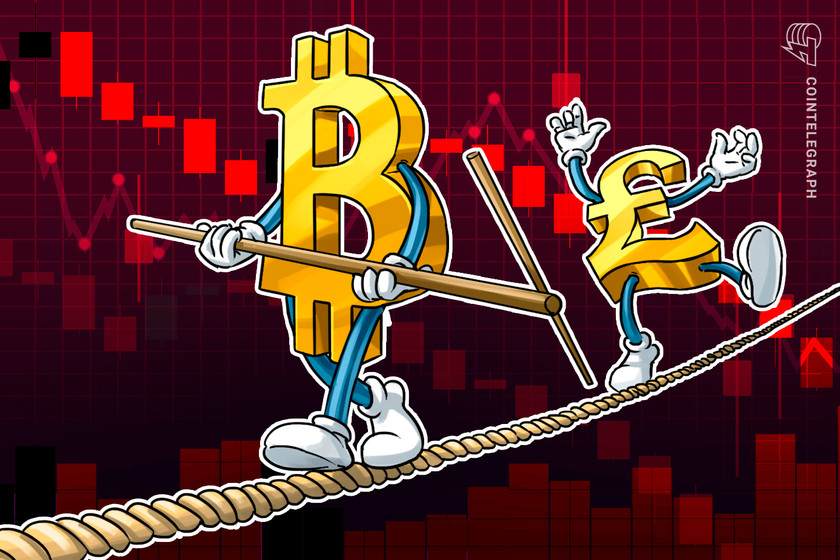‘Get ready’ for BTC volatility — 5 things to know in Bitcoin this week


Up or down, it is high time that Bitcoin made a significant move, market participants agree.
Bitcoin (BTC) starts a new week keeping everyone guessing as a tiny trading range stays in play.
A non-volatile weekend continues a familiar status quo for BTC/USD, which remains just above $19,000.
Despite calls for a rally and a run to lower macro lows next, the pair has yet to make a decision on a trajectory — or even signal that a breakout or breakdown is imminent.
After a brief spell of excitement seen on the back of last week’s United States economic data, Bitcoin is thus back at square one — literally, as price action is now exactly where it was at the same time last week.
As the market wonders what it might take to crack the range, Cointelegraph takes a look at potential catalysts in store this week.
Spot price action has traders dreaming of breakout
For Bitcoin traders, it is a case of “almost too quiet” when it comes to the BTC/USD weekly chart.
Having come down significantly in volatile conditions over the first half of 2022, recent months have seen an almost eerie lack of volatility.
Data from Cointelegraph Markets Pro and TradingView proves the point — on one-week timeframes, Bitcoin continues to print candles with almost nobody whatsoever.
Such is the stickiness of the current range that, as Cointelegraph reported, the Bitcoin historical volatility index (BVOL) is at lows only seen a handful of times.
“Equity volatility (VIX) relative to Bitcoin volatility (BVOL) is approaching all-time highs,” William Clemente, co-founder of digital asset research and trading firm Reflexivity Research, added in comments last week:
“This illustrates just how much volatility compression Bitcoin is currently experiencing.”
An accompanying chart neatly captured Bitcoin as a curiously stablecoin-esque pick in the current climate, with Clemente implying that a return to the classic, more volatile paradigm should follow.
The week prior, economist, trader and entrepreneur Alex Krueger additionally noted that an “explosive move” had followed all prior trips to macro lows on BVOL.
He argued that United States macro data missing expectations “would do it” in terms of rekindling volatility, but in the event, the numbers remained just short of the trigger range.
Cryptocurrency research firm Delphi Digital agreed.
“Historically speaking, when the BVOL falls below a value of 25, a large spike in volatility tends to follow shortly thereafter,” it stated in part of Twitter comments.
This week, meanwhile, popular crypto investor and analyst Miles Deutscher told traders to “get ready” while commenting on the Delphi data.


The question for everyone remained the direction that volatility would take the market in.
For Il Capo of Crypto, the trader who predicted Bitcoin’s descent to $20,000 levels from all-time highs, expectations remained the same.
$21,000 should feature as part of a relief bounce, only to be eclipsed by a fresh dive to multi-year lows for BTC/USD, these potentially coming in at $14,000-$16,000.
“Some shitcoins will experience scam pumps during these days, while $BTC goes to 21k. This could give you the illusion that the bull market is back,” he warned over the weekend:
“My advice: don’t be greedy. Take profits if this happens. Protect your capital.”


Fresh macro triggers line up for crypto
While little is expected from the Federal Reserve in terms of direct policy changes this week, there is still plenty of firewood for crypto volatility set to be provided by external forces.
In the United States, company earnings will be coming in thick and fast, with tech stocks particularly apt to move markets in the event of results falling wide of expectations.
Reporting firms represent over 20% of the S&P 500, which like other U.S. indexes is showing rare weakness this year.
“In my mind, the odds of a low coming in the next week or two are decently high,” Raoul Pal, founder and CEO of RealVision, predicted overnight alongside an accompanying chart:
“The SPX weekly DeMark hits next week, near the bottom of the channel and the 50% retracement, with RECORD bearish sentiment.”


Charting the week ahead, financial commentary resource the Kobeissi Letter likewise told subscribers to “prepare for more volatility.”
More U.S. data will join earnings this week, it explained, while Fed officials will comment on overall policy.
“The median bear market with a recession dating back to 1929 has fallen 39%,” it wrote about stock market strength in one of the various posts over the weekend:
“Furthermore, the median bear market with a recession lasts 16 months. We are currently only 10 months in and the S&P 500 is down just 28%. History continues to suggest that more pain is ahead of us.”
Beyond stocks, the U.S. dollar index (DXY) was mercifully motionless into the new week, so far avoiding another attack on twenty-year highs seen earlier.
Echoing Il Capo of Crypto’s theory, Michaël van de Poppe, founder and CEO of trading firm Eight, hinted that it could be this week or next that “some relief” enters for risk assets more broadly.
“A crucial area for Bitcoin, as it’s still hovering in the range for more than a month,” he summarized on the day:
“It needs to break $19.4-19.6K clearly. If that happens, volatility can finally kick in. Given the structure of the $DXY and the Yields, I expect this to occur in 1-2 weeks.”


RSI breakdown risk echoes 2018
Further out, the picture for Bitcoin becomes murkier, and those divining bearish scenarios from current chart data are busy channeling comparisons to the 2018 bear market bottom.
Among them is popular analyst Matthew Hyland, who even in his characteristic bullish market takes has little to celebrate when it comes to the next few months’ BTC price action.
In a tweet from this weekend, Hyland flagged Bitcoin’s relative strength index (RSI) repeating behavior seen in the build-up to the 2018 floor.
An accompanying chart clearly demonstrated familiar bear market forces in play, adding to suspicions that Q4 2022 could closely mirror the scenes from four years ago.
Trading account Stockmoney Lizards confirmed that it “100% agreed” with the idea, which uses the 3-day chart.


The 2018 RSI breakout structure involved a dive from $5,500 to $3,100 for BTC/USD — or roughly 40%.
“Obviously, we’re still waiting for this huge move to come,” Hyland added in a related video about the idea.
He additionally showed that the classic Bollinger Bands volatility indicator was still predicting an incoming storm, with narrowing bands demanding a breakout of volatility.


Hodlers stay as determined as ever
Taking a look at hodler behavior and it becomes apparent that the resolve of the average long-term holder (LTH) remains steadfast.
The latest data from on-chain analytics firm Glassnode confirms a five-year high in the number of Bitcoin either lost or out of circulation in cold storage.
The “hodled or lost coins” metric put the tally at 7,554,982.124 BTC — or 40% of the current supply — as of Oct. 17, meaning that more BTC is off the market than at any time since late 2017.


Likewise, distribution is also continuing an accelerating trend visible throughout 2022. The number of wallets with a balance of at least one whole Bitcoin is now at an all-time high of over 908,000.
While increasing overall through the latter half of 2021, the trend has gained noticeable momentum this year, Glassnode shows.


Analyzing lost coins as part of its weekly newsletter, “The Week On-Chain,” Glassnode, meanwhile, concluded that the current bear market has yet to match others in terms of intensity when it comes to hodlers.
“Network profitability has not quite hit the same level of severe financial pain as past cycles, however adjustment for lost and long HODLed coins can explain a reasonable portion of this divergence,” it explained last week.
Nonetheless, when it comes to those used to hodling through bear markets, it appears that there’s little appetite for capitulation from current price levels.
Fear enters its second consecutive month
There seems to be no shaking the fear when it comes to crypto market sentiment.
Related: ‘No emotion’ — Bitcoin metric gives $35K as next BTC price macro low
In a sign which has captured the industry this year, the Crypto Fear & Greed Index has now had sentiment in its “fear” or “extreme fear” for two months straight.
Fear & Greed uses a basket of factors to compute a normalized score for market sentiment, and 2022 has delivered results unlike most years.
Earlier, the Index saw its longest-ever stint in “extreme fear,” a feat which is currently one month away from repeating.
As of Oct. 17, the Index measured 20/100 — around 10 points higher than classic bear market bottoms but a full 14 points higher than this year’s low.


The views and opinions expressed here are solely those of the author and do not necessarily reflect the views of Cointelegraph.com. Every investment and trading move involves risk, you should conduct your own research when making a decision.



































